Research Facilities
Skidmore's Dana Science Center houses nine biology teaching laboratories and specialized research facilities in which students and faculty investigate microbiology, molecular genetics, cell and developmental biology, animal physiology, plant biology, genetics, ecology, evolution and behavior. Skidmore's 400 acre North Woods serves as the campus natural laboratory.
Research and Teaching Laboratory Resources
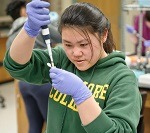 |
Gene Expression | 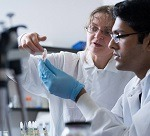 |
Microbiology |
 |
Comparative Physiology |  |
Developmental Neurobiology |
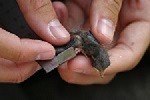 |
Molecular Ecology | 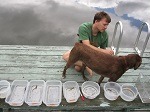 |
Community Ecology |
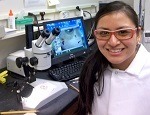 |
Circadian Rhythm |  |
Microscopic Imaging |
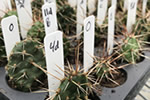 |
Greenhouse | 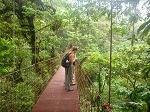 |
Behavior and Ecology |
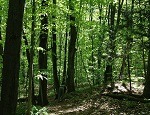 |
North Woods |
Gene Expression Laboratory - State of the art laboratory includes quantitative RealTime PCR, Storm phosphoimaging with ImageQuant analysis, vertical gel electrophoresis, Zeiss Tetrad dissection microscope, UV/Vis spectrophotometer, heating/cooling growth chambers and -80°C freezer.
Comparative Physiology Laboratory - The comparative physiology laboratory consists of a dedicated research laboratory and accompanying animal facility for the rearing and spawning of multiple fish species (including zebrafish, killifish, tilapia). A quantitative PCR machine, gel electrophoresis equipment, a fluorescent dissecting microscope, a -80°C freezer, and other equipment supports physiological analyses ranging from the molecular to organismal levels.
Molecular Ecology Laboratory - The molecular ecology laboratory is equipped for analyses using single- and multi-locus probes and PCR in the investigation of parentage and population structure. The lab is supported by automated DNA sequencing capability and a dedicated ultra-low temperature freezer to maintain the specimen library.
Circadian Rhythm Laboratory - The circadian rhythm laboratory is equipped for automated monitoring and analysis of up to 64 rodents in running wheels under controlled photoperiods for circadian rhythm analysis, has facilities for rearing and automated recording of fruit fly locomotor activity, and Actiwatches for automated recording of human activity rhythms.
Greenhouse - Skidmore's new greenhouse was created in 2019 to support teaching and research. It includes a large display room containing a variety of plant species, as well as independent experimental modules where temperature and humidity can be altered to mimic particular climates. The greenhouse also includes Biology's Community Ecology research lab.
North Woods - Skidmore's on-site outdoor laboratory, the 400 acre North Woods , includes northeastern deciduous forest, wetlands, and old field succession at disturbed sites. Skidmore's sustainability coordinator and two North Woods Sustainability Stewards work to maintain trails, inform visitors, conduct public outreach and promote responsible stewardship of the North Woods community.
Microbiology Laboratory - Adjustable temperature incubators in the microbiology laboratory support the isolation and culture of a variety of bacterial species. The laboratory is also equipped to genetically manipulate and analyze bacterial model organisms via PCR, transformation and electrophoresis.
Developmental Neurobiology Laboratory - An 80-tank fish facility houses numerous transgenic, mutant and wild-type zebrafish. Two microinjection rigs allow injections at the one cell stage for gene knock down experiments. PCR machines, gel electrophoresis and other molecular biology equipment support mRNA expression studies through in situ hybridization. Several incubators are used to culture zebrafish embryos and raise fry to adulthood
Community Ecology Laboratory - The community ecology laboratory utilizes adjacent outdoor habitats, including the 400 wooded acres next to the college and the streams of the upper Hudson watershed. We bring elements of these habitats indoors by using replicated indoor stream ecosystems, motion-sensitive infrared cameras, metabolism chambers and Skidmore's interdisciplinary GIS center.
Microscopic Imaging Facilities - Skidmore Microscopy Imaging Center (SMIC) comprised of five modern laboratories in the Dana Science Complex: Lintilhac Light Microscopy Laboratory established with the a generous donation of the Crea Lintilhac '74 and Philip Lintilhac Foundation. It contains five microscopy work stations-Olympus BX63 light microscope, Olympus IX83 light microscope, Olympus BX-60 light microscope, Olympus IX-70 light microscope and Olympus SZX-12 light microscope; Confocal laser scanning microscopy laboratory maintains two confocal laser scanning microscopes: an Olympus Fluoview 1200 confocal supported by funding from the National Science Foundation's Major Research Instrumentation Program, and an Olympus Fluoview 300 confocal supported by a grant from the Alden Trust Foundation; Scanning electron microscopy laboratory includes a JEOL 6480LV SEM and FEI Field Emission SEM, both was purchased with funds from the National Science Foundation. Transmission electron microscopy laboratory currently maintains a Zeiss libra 120 plus TEM purchased in 2010 with support from a National Science Foundation-Major Research instrumentation grant. To learn more about microscopy at Skidmore, visit the Skidmore College Microscopy Imaging Center (SMIC) website.
Behavior and Ecology Laboratory - Behavioral and ecological research utilizes habitats including Skidmore's North Woods, local farms, zoos and other animal care, exhibit and training facilities throughout the Northeast, and the cloud forest of Monteverde , Costa Rica. Aquaria, terraria, small aviaries and observation hives house fish, reptiles, finches and insects for teaching and indoor experimental investigations.